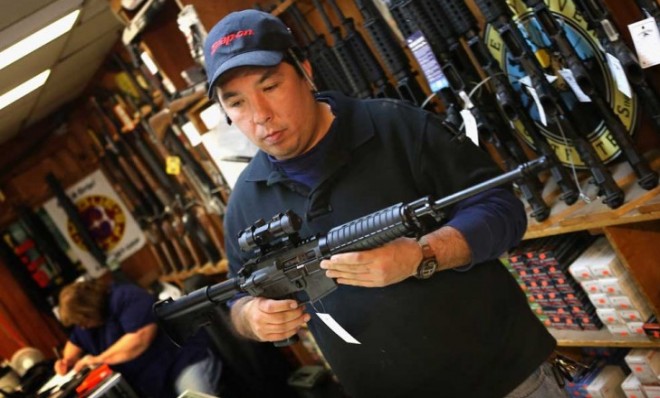The assault weapon: An instant guide
Especially since the Newtown massacre, military-style rifles have become the focus of America's gun debate

What is an assault weapon?
The term is notoriously difficult to define. Colloquially, it is used to describe commercially sold semiautomatic rifles with military-style features, including pistol grips, flash suppressors, and large, detachable magazines. Like any semiautomatic gun, these rifles don't need to be reloaded after each shot; depending on the size of the clip or magazine attached, they can fire anywhere from 10 to 100 rounds, with each pull of the trigger firing a single round. Unlike military assault weapons, they are not automatic — that is, they do not fire continuously as long as the trigger is depressed. Automatic weapons — "machine guns" — are essentially illegal for civilian use. Second Amendment advocates argue that "assault weapon" is largely meaningless, since it refers principally to cosmetic features such as flash suppressors and pistol grips. Any semiautomatic hunting rifle or semiautomatic pistol, they say, is just as lethal in the hands of a criminal or madman.
How did assault weapons originate?
The Week
Escape your echo chamber. Get the facts behind the news, plus analysis from multiple perspectives.

Sign up for The Week's Free Newsletters
From our morning news briefing to a weekly Good News Newsletter, get the best of The Week delivered directly to your inbox.
From our morning news briefing to a weekly Good News Newsletter, get the best of The Week delivered directly to your inbox.
The first was the Sturmgewehr 44, or "storm rifle," developed in Nazi Germany during World War II and named by Adolf Hitler himself. The Russians used that design as the basis for their AK-47, still a popular template for many so-called "selective-fire" military assault rifles that work in both semiautomatic and automatic modes. In the U.S., the small-arms engineering company ArmaLite developed its own selective-fire weapon, the AR-15, in 1957. The firearms manufacturer Colt acquired that design and used it to produce the M16 for American forces in Vietnam, reserving the designation AR-15 for a semiautomatic version marketed to civilians. Many other manufacturers now make versions of the AR-15; Adam Lanza used a Bushmaster model in the December massacre at Sandy Hook Elementary School in Newtown, Conn. In killing 20 first-graders and six adults, Lanza fired hundreds of rounds, shooting each child three to 11 times.
How many are out there?
Government data shows that there are approximately 310 million firearms in the U.S., including 114 million handguns, 86 million shotguns, and 110 million rifles. How many of the latter are "assault-style rifles" is uncertain, but some analysts have estimated that the number is about 4 million. There's no doubt that sales of assault-style rifles are booming: Smith & Wesson's sales of its M&P15 assault rifle exploded from 4,600 in 2006 to 100,000 in 2010. "That category of firearms has been a primary growth engine and profit driver for firearms companies for the last seven or eight years," said industry analyst Rommel Dionisio.
Why are these guns so popular?
A free daily email with the biggest news stories of the day – and the best features from TheWeek.com
Designed to look menacing, they're lightweight, can fire 50 or more rounds per minute, and are relatively easy to use, with a light kick. "Guns are fun," said Philip Van Cleave, a Virginia gun activist, "and some of them are much more cool than others." For many gun-rights defenders, however, the real appeal of assault weapons is that they are the closest a civilian can get to wielding military firepower. "The principle underlying the Second Amendment is resistance to federal tyranny," says David B. Kopel of the Cato Institute. "The weapons that would be most suited to overthrow a dictatorial federal government would, of course, be weapons of war, and not sports equipment."
How often are assault weapons used in crime?
Rarely. FBI data shows that in 2011, 6,220 murders were committed with handguns, compared with 323 committed with rifles — only some of which were assault rifles. Killers who set out to massacre large numbers of people, however, often choose assault weapons, including James Holmes in Aurora, Colo. (12 killed, 58 wounded), and Lanza in Newtown (26 killed). Killers used assault weapons in 25 of the 62 mass shootings in the U.S. since 1982, a Mother Jones analysis found — that is, in 40 percent of such crimes. Another study found that mass killers who use assault weapons and/or high-capacity magazines have more than twice the number of victims, with an average of 15.6 people shot.
So how effective would a ban be?
It would have little impact on the 30,000 annual murders, homicides, accidents, and suicides involving firearms, since most are committed with handguns. The evidence, however, suggests an assault weapons ban might have some impact on mass shootings. During the decade the 1994 assault weapons ban was in place, mass shootings declined — with one notable exception, the 1999 massacre at Columbine High School in Colorado (in which one of the perpetrators' four guns was an assault weapon). Since the ban expired, the annual average toll from mass shootings has more than doubled, from 21 victims per year to 55. Christopher Koper, a criminologist who conducted a Justice Department review of the 1994 ban, thinks a renewed ban would "modestly" reduce gun deaths "by reducing gun attacks with particularly high numbers of shots fired." He estimates that a ban would prevent more than 100 shooting deaths a year. Given the horror and fear that incidents like Aurora and Newtown evoke, Koper said, "I wouldn't consider this trivial."
Australia's semiautomatic rifle ban
In 1996, a disturbed Australian gunman named Martin Bryant used two semiautomatic rifles to kill 35 people and wound 23. Shocked by the scale of the killings, Australia reacted by banning all semiautomatic and automatic rifles and shotguns. The ban was retroactive, so the government also funded a mandatory buyback program for all such weapons. Nearly 700,000 weapons were bought back. And what were the results? In the 18 years before the 1996 ban, Australia suffered 13 gun massacres — each with more than four victims — causing a total of 102 deaths. There has not been a single massacre since then. "Few Australians would deny that their country is safer today," says former Prime Minister John Howard. But Howard notes that Australia and the U.S. are very different nations. "Our gun lobby isn't as powerful or well-financed as the National Rifle Association," he says. "Also, we have no constitutional right to bear arms." For those reasons, an Australian ban-and-buyback plan would have virtually no chance of passing through Congress.
-
 A luxury walking tour in Western Australia
A luxury walking tour in Western AustraliaThe Week Recommends Walk through an ‘ancient forest’ and listen to the ‘gentle hushing’ of the upper canopy
-
 What Nick Fuentes and the Groypers want
What Nick Fuentes and the Groypers wantThe Explainer White supremacism has a new face in the US: a clean-cut 27-year-old with a vast social media following
-
 5 highly amusing cartoons about rising health insurance premiums
5 highly amusing cartoons about rising health insurance premiumsCartoon Artists take on the ACA, Christmas road hazards, and more